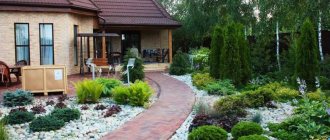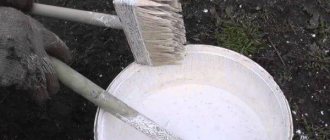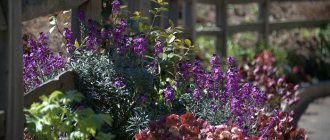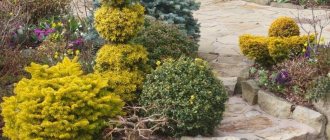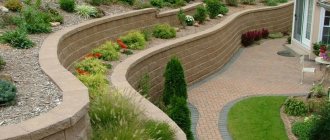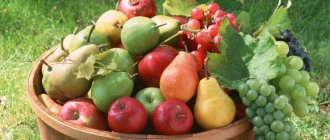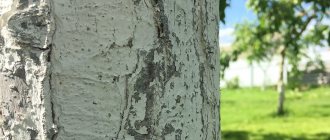Low growing ornamental trees
Small ornamental trees look great in the garden and can complement small areas.
The most famous are:
Warty birch.
An elegant variety of small sizes, it looks very delicate. This type of birch develops extremely slowly, the maximum height is 5 meters, which it reaches only after 20 years.
The plant is unpretentious, resistant to various influences (heat, cold). The culture prefers light-loving areas.

Prickly hawthorn "Paul Scarlett".
Decorative low-growing tree for a small garden, the height of which is 5-6 meters. It has double flowers of a dark pink color, they are formed into voluminous inflorescences. In rare cases, the culture bears fruit.
The flowering of prickly hawthorn begins in May and lasts until June.
The crop can withstand pruning well, so it can easily be given the desired shape. In winter, it is better to cover the plant, since it is very afraid of cold weather.

Options for low growing trees
Low-growing trees form the front composition of the garden, so it is important not to go wrong with the choice of vegetation that will be the first to attract attention. One of the beautiful trees is the warty birch. It has hanging branches with light, lacy foliage. Such a tree will slowly increase in size and reach its maximum size of five meters approximately twenty years after planting.
Warty birch can withstand low temperatures and dry conditions, but prefers good light.
You can also place Paul Scarlet hawthorn in the garden. These small ornamental trees have delicate pink blooms in May and June. Hawthorn rarely bears fruit. Such a plant can be trimmed and decorated in different shapes so that the garden impresses not only with its color scheme, but also with its geometry.
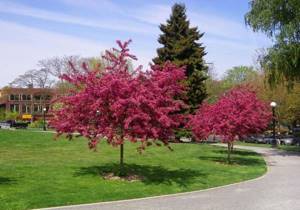
Tip: in the winter season, cover the prickly hawthorn to protect it from the cold.
We recommend paying attention to evergreen ornamental trees, which will decorate the natural corner of your summer cottage in any season. Small trees of this type include Daurian juniper. It has thick branches with needles and grows up to 1.5 meters. But the width of such a plant can be about three meters, so with the help of juniper you will decorate large areas. This decorative tree looks original even in a pot.
High and low temperatures do not have a negative impact on these trees, and constant care is not needed to maintain their beauty.
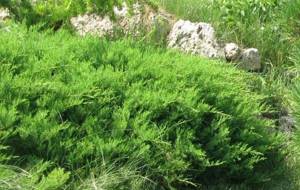
Dwarf ornamental trees for the garden can be chosen at the same time as flowers and bushes. In this case, you will be 100% sure that the landscape design will look harmonious.
Plants for a regular garden
This option for decorating a local area involves planting vegetation along clear geometric lines, where thorough care of the plantings will be required: shrubs and trees for the garden are carefully trimmed to obtain the correct shape.
Such a garden is characterized by hedges of any type, so plant varieties that can withstand pruning are often used.

To form a low green fence, the following is suitable:
- golden currant;
- small-leaved linden;
- boxwood evergreen;
- shrubby cinquefoil;
- yew berry;
- common spruce.
If the goal is to create a high molded hedge , then you should pay attention to plants such as:
- small-leaved elm;
- thorn;
- Virginia juniper;
- barberry;
- thuja occidentalis.
Decorative trees for the garden: how not to make a mistake with your choice?

Ornamental shrubs and trees are divided into several types: evergreen, decorative deciduous and flowering. If you are one of those people who do not have time to create a beautiful garden, then you need to turn your attention to the first two groups of plants. All three groups are suitable for energetic gardeners.
No one will deny that in the spring and summer the summer cottage looks very beautiful: green shades, bright colors and many, many flowers make the area attractive. But I really want to preserve this beauty forever. In this case, evergreen trees and shrubs are the best solution. It is not recommended to plant large pines or spruces on the site, but it is worth thinking about small plants. We offer photos with the names of the most suitable options:
All types of coniferous plants tolerate pruning, changing climates and even strong drops in temperature. Their most important advantage is that they require virtually no maintenance. And in order for a shrub or tree to be better accepted, experts recommend giving preference to young individuals. They tolerate transportation and transplantation better.
decorative deciduous plants that deserve to take place in garden plots. They will decorate any area and, with proper care and abundant watering, will delight the owners for a long time. The most common ones include:
- Barberry.
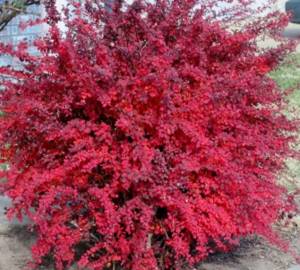
Barberry
- Derain is white.
The place for decorative deciduous plants must be prepared in advance, having precisely determined the chosen location on the site. Before planting, the first layer of soil must be removed by placing it in a nearby film. The hole itself must be twice the size of the plant’s root system. A small amount of drainage, peat, humus and sand are placed at the bottom. It is better to mix all these components in advance. Organic fertilizers and water are also added to the pit.
Beautifully flowering shrubs are important plants in creating a delightful park. Among the wide variety of species, I would like to highlight those that bloom for a certain period of time, for example:
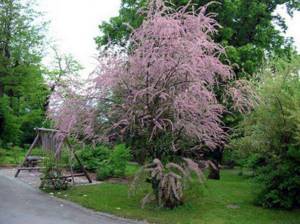
- Forsythia.

Forsythia
- Spirea.
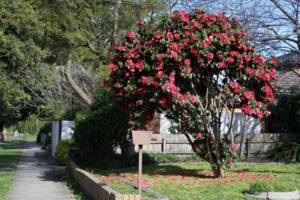
Ornamental trees for the garden are a win-win option for a delightful, cozy and attractive garden. Why not take our advice and plant several ornamental plants on your site? You will be very surprised how quickly your site will transform and take on a completely different look.
I have a very small area, which is why I have to constantly experiment. Several years ago I planted dwarf varieties of apple and pear trees, and this season I have already harvested my first harvest.
Vegetation for a landscape garden
This type of personal plot is an untouched corner of nature, where trees and shrubs for the garden grow in their original form, without strict order and forms. The choice of green vegetation is quite wide, since the only criterion is the tree’s susceptibility to the conditions of a particular area.
Otherwise, it is up to the imagination of the landscape designer.
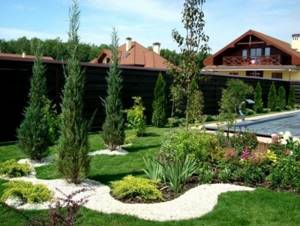
Both deciduous and coniferous plants are suitable for a landscape garden Among the favorites are the following types:
- spirea;
- snowberry;
- lilac;
- maple;
- cotoneaster;
- birch;
- mock orange;
- vesicular carp.
Many of them bloom beautifully, and some varieties even bear edible fruit in the fall.
Frost-resistant ornamental trees for the garden
Another important characteristic is frost resistance. Among the trees popular in landscape design, the following have excellent frost resistance:
Birch Doorenbos.
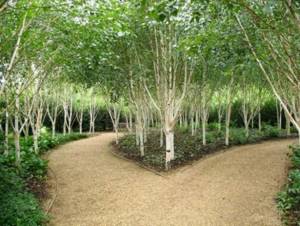
The most white-trunked among all varieties of birch.
The plant's outstanding frost resistance is due to its region of origin - the Himalayan mountains.
It is a multi-stemmed tree, up to 10 meters high. Even thin branches have a white bark.
Norway maple Royal Red.
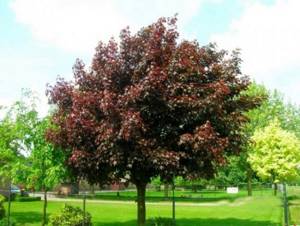
A tree with spectacular red and black-red foliage, reaching a height of 10-12 meters. Does not require formation, independently forms an even pyramidal crown.
It tolerates frosts easily, only in very severe winters can annual shoots freeze.
Mountain ash.

It reaches a height of 10-15 meters and is famous for its openwork decorative foliage, spectacular flowering and fruiting. Flowers, depending on the variety, can be white or pink, fruits - orange, red, yellow.
The plant is resistant to diseases and pests and tolerates difficult climatic conditions.
High frost resistance of plants manifests itself with age. Young one- to two-year-old seedlings may require the creation of a basic winter shelter.
Combination of types of landscaping with each other
There are a large number of types of landscaping. They can be vertical or horizontal. These types can be planned and combined with each other so that the yard looks harmonious in the overall landscape design. To do this, it is important to determine the direction of illumination, the depth of groundwater flow, and the quality of the soil.
If you have a proper drainage system, you can hope for successful landscaping of the site. Most experts recommend using plants in landscaping that are very resistant to adverse conditions and are easy to care for. For landscaping, it is important that plants maintain their color all year round.
You may be interested in: We lay out garden paths with our own hands from stone, plastic or wood
Each of the plants involved in landscaping must be harmoniously selected, and their planting must be planned. For horizontal gardening, it is necessary to use grass seeds that will actively grow throughout the existing flowerbed. Vertical gardening includes planting trees.
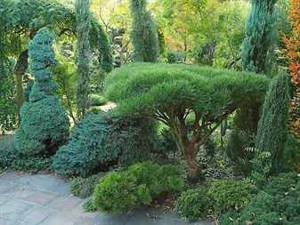
Decorative forms of fruit trees
Some common fruit crops can also have decorative varieties and be used on the site as decoration:
Kiku-Shidare cherry.
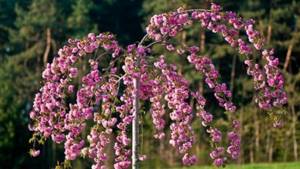
A variety of Japanese cherry (sakura) with drooping arched shoots. It blooms at the end of March, forming lush bunches of large double flowers of pink color. The fruits are edible and have high frost resistance.
Niedzwiecki apple tree.
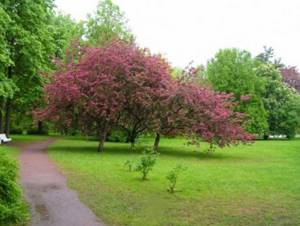
A small tree with small edible apples. Valued for its highly decorative umbrella crown and magnificent flowering. The foliage turns purple in summer. The flowers are large, crimson in color. Subject to formative pruning, it does not grow higher than 6-8 meters.
Quince is often planted as an ornamental crop . This plant has a bushy form and is characterized by lush flowering.
The main advantages of growing dwarf fruit trees in the garden
Dwarf fruit trees have become very popular all over the world due to some significant advantages. The main advantages are:
- early period of fruiting;
- ease of maintenance required;
- high annual yields;
- the small area they occupy.

A very important parameter, which to some extent affects both industrial and individual gardening, is the very early period of fruiting. In addition, these crops are ideal for any garden because they produce a fairly good harvest.
Due to the fact that the height of the low-growing trees themselves is no more than 2 m, and their crown does not grow very much, they are very easy to care for even from a human height. Each harvest and pruning of shoots can be done directly from the ground, and there is no need to additionally use a stepladder.
The main advantage of dwarf trees is that they have very high overall yields and produce much larger yields than traditional varieties.
Coniferous and evergreen trees
Coniferous and evergreen plants complement deciduous trees, giving the site a decorative appearance even in winter. They also differ in final sizes, as well as growth rates and crown shape:
Nootka cypress Pendula.

Weeping form with shoots tending to the ground. The plant gives high annual growth, by 10 years it reaches a height of 3 meters and lives for centuries.
The needles are dark green, the crown is pyramidal, with a hanging crown, good frost resistance.
Thuja Smaragd.

One of the most popular varieties in Russia, capable of rapid growth. An unpretentious plant with a pyramidal crown, up to 3 meters high. It tolerates haircuts well, is resistant to frost and does not become exposed in the lower part.
It retains the green color of the needles well and does not turn yellow with normal watering.
The most beautiful trees for landscape design
An alternative to expensive introduced plants can be modern species and varieties of quite ordinary plants. The most beautiful ornamental trees can give the garden an exotic look:
Birch Royal Frost.

An unpretentious, but visually spectacular variety of silver birch with dark red foliage. The seedlings have a bronze tint of bark, but with age it turns white, and the decorative value of the plant increases.
Maple Atropurpureum.

An unusual variety with an umbrella crown and scarlet leaf color. The flowers also have a purple tint. It goes well with coniferous trees, creating a bright spot of color against their background.
Acacia tree Pendula.
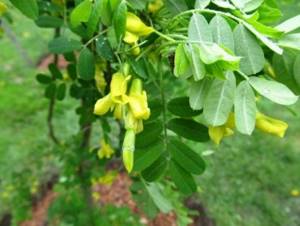
Weeping form with graceful long shoots. It has decorative foliage and blooms with yellow fragrant flowers. Tolerates frost, drought and pruning well.
Having a crown height and diameter of only 2 meters, it does not take up much space on the site.
Rowan Kirsten Pink.
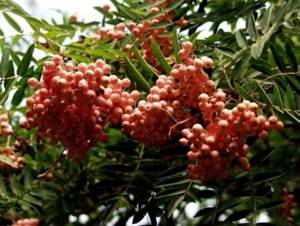
Frost-resistant multi-stemmed tree with slow growth and a highly decorative openwork crown. Particularly effective during flowering and fruiting. Fruits of unusual pink color.
Amanogawa cherry (Prunus serrula Amanogawa)
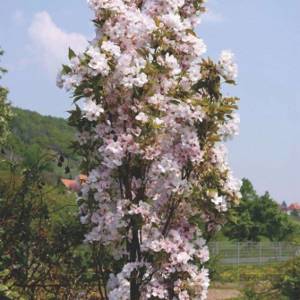
A good option is to choose a small tree for the site, which will delight you with its lush blooms in the spring.
One of these is the cultivated form of Amanogawa cherry. This tree has a dense columnar crown up to 2 m wide and grows to 4-7 m in height. In spring it bears beautiful clusters of double, soft pink flowers. Amanogawa does not bear fruit, so it is unlikely that you will be able to enjoy the fruits of ripe cherries.
But it will delight you with flowering every spring.
For planting this cherry, sunny places protected from cold winds with fertile, moderately moist soil are suitable. Amanogawa is afraid of severe frosts, therefore it is recommended for cultivation in regions not north of the sixth climate zone (from –23 to –18°C).
It is also important that this decorative cherry is beautiful not only in the spring during flowering, but also in the fall, when its leaves acquire a fiery red color.
Hawthorn (Crataegus)
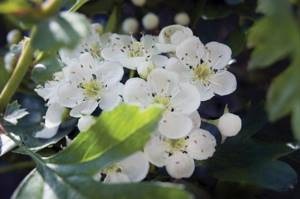
Scarlet hawthorn can be found in many gardens. It usually grows up to 6 m in height (very rarely up to 12 m). The popular names of this plant are “glod”, “boyarka” or “lady”.
It has long been appreciated for its unpretentiousness and amazing medicinal fruits.
Due to its small growth, this plant is ideal for small areas. Often, hedges are made with the help of hawthorn: they not only look amazing, but will also provide reliable protection for the area.
Hawthorn begins to bloom at the beginning of summer and blooms for 1-2 weeks.
Flowers with a diameter of 12-15 mm, united in lush inflorescences, are painted golden-white. Hawthorn fruits are small berries of bright red or orange color with mealy pulp, used in medicine, and also as a vitamin supplement for poultry.
Canadian Cercis (Cercis Canadensis)
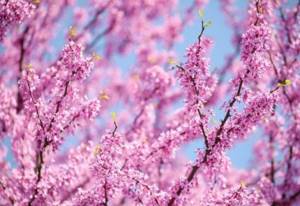
One of the most beautiful spring trees, which does not exceed 8 m in height, is Cercis canadensis, or “forest pansy”. It is beautiful in early spring, captivating with its blooms. In the southern regions it grows as a shrub.
Usually, growing Canadian cercis in open ground and caring for it is not difficult, but it is important to choose the right variety.
This plant is considered the most frost-resistant of its fellows, so it is quite famous in the European part of Russia.
Although the places that start north of the Voronezh region are no longer suitable for growing it: it will freeze and will not bloom. The climate of the Moscow region is also not suitable for cercis - it, of course, will not die, but it will not please you with luxurious flowers.
Gray maple (Acer griseum)

Gray maple has gained widespread popularity due to its unusual chestnut-colored peeling bark.
This distinctive feature allows the tree in winter - against the backdrop of the winter sky and snow-covered ground - to look much more interesting than in the warm season.
Although in the fall, thanks to its ruby-colored leaves, the gray maple looks no less attractive and luxurious.
It grows in height up to 6-10 m, and its crown in diameter can reach 7.5 m. This tree is not afraid of even very severe frosts - it can withstand frosts down to –45°C. However, if your garden is very modest in size, it is better to avoid planting this plant.
tall trees
The central composition or background can be created using decorative trees of coniferous and deciduous varieties.
Planting such vegetation will create shaded areas where you can retire or hide from the scorching sun. A traditional decoration for many gardens is the chestnut tree. It has a rough and wide trunk and large foliage. During the flowering period, it blooms snow-white or pale pink flowers. Chestnut fruits look like nuts in light green boxes. Plant a few chestnuts in your garden and they will prevent the spread of dust and clean the air in your area.
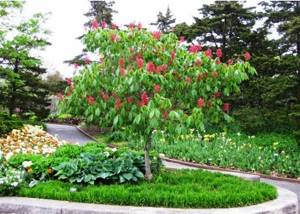
Decorative trees: photos and names
If you want your garden to remain green even in winter, plant tall spruce trees. These trees have a low growth rate, but survive for 250 years. By the way, such a garden will look especially charming on New Year’s Eve, since you can decorate the spruce with decorations traditional for the winter holidays.
Don't forget about oak. Despite its massive and rough appearance, oak can become the main decoration of your garden. This tree bears fruit after thirty years of growth: the acorns can be used for healing.

Decorative trees for the garden: photos and names
Another suitable tree is called catalpa. It needs careful watering and enough light to maintain growth. The maximum height of such a tree can reach thirty meters. During the flowering period, catalpa is covered with white flowers.
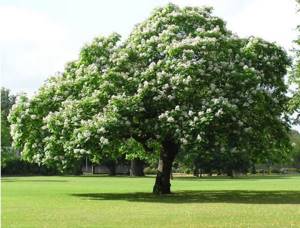
Decorative catalpa tree, photo
When choosing tall vegetation, you should focus not only on the beauty of the trees. It is important that they can grow freely, so do not plant them close to each other so that the crown can freely increase in size. Decorate the free space with rose hips, snowberries or cinquefoil.
Read about how to choose the right ornamental grasses for a flower bed: names and photos will help you choose the best types and varieties of herbs and grains for flower beds in the garden.
See options and ideas for decorating your garden with your own hands from unnecessary things here.
For diagrams of mixborders made from shrubs and perennials, see the article at:
Growing Requirements
The rich and diverse group of ornamental deciduous trees includes trees for a variety of conditions. Some grow without problems in dry places, others need fertile and fresh soil.
Although in general deciduous trees do not respond well to drought, winter road salinity and air pollution, which are sometimes fatal to them, recently there are more and more resistant varieties grown specifically for difficult urban conditions.

Landing
Deciduous trees can be purchased with bare root systems, in a lump or in a container. Some types of trees that have difficulty taking root cannot be purchased bare root.
Deciduous trees with bare root systems should be planted in early spring or late autumn, never with leaves.
Plants in containers all year long as long as the soil is not frozen. When choosing a place to plant a tree, you need to take into account the size of the tree in the future, as well as its growth rate. This will help us avoid problems and the plant will delight us for many years. Trees are usually planted 5-10 cm deeper than they have grown so far. After planting, until the tree takes root and becomes stronger, it should be tied to a support.
When planting large, formed specimens, it is necessary to limit the transpiration (evaporation) of water, for which the trunk should be wrapped in burlap.
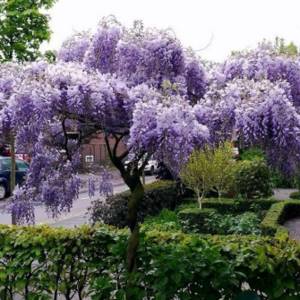
Care
We water the trees as needed, fertilize them in April. A very important tree care operation is pruning. It is carried out in winter or early spring. The formation of the crown begins in the nursery and continues after planting in a permanent place.
The process is completed by raising the trunk to the required height and giving the crown shape characteristic of this variety.
The height of standard and grafted varieties depends on the rootstock and grafting height. Sanitary pruning is carried out annually, removing dry, broken or unwanted shoots.
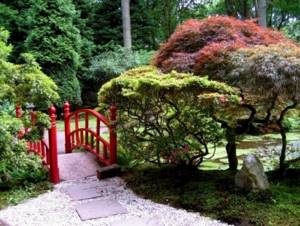
Using pruning, you can form artificial crowns, oval, umbrella, etc. The most suitable species for forming a crown in the initial stage of growth: linden, plane tree, beech, field maple.
Clipped, artificially shaped crowns require a lot of skill and constant care, some of them require special metal or bamboo trellises in the initial stage, but in prominent places, in squares, near shopping centers or in small gardens and recreation areas, this gives them a stunning effect .
Every year we carry out sanitary pruning, which consists of removing dry, diseased and broken branches.
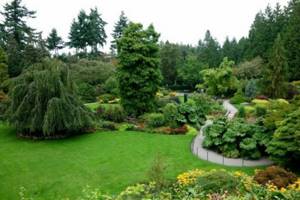
Usage
Deciduous trees are used in private gardens and urban landscaping - in parks, squares, along streets. It is difficult to imagine a landscape without deciduous trees. Deciduous trees can be planted individually or in groups, in the form of hedges, trellises or alleys.
Separately planted deciduous trees form an excellent geometric crown shape inherent to this species, but require quite a lot of free space and lighting from all sides.
Deciduous trees can be the main element of compositions, forming the basis which we later supplement with various plants, or serve as a background for them. At the moment there are no problems with choosing low varieties for small areas or city balconies.
Over the past few years, a huge number of decorative varieties of deciduous trees have been introduced to the market, varying in shape and color for creating compositions.
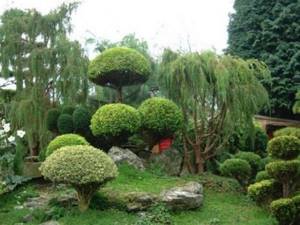
Coniferous ground cover
ground cover coniferous plants play a significant role in securing and decorating embankments and slopes . Nurseries now offer a large selection of species and varieties of creeping junipers, pines, spruces and other conifers, extremely diverse in bush shape, texture and shades of needles.
These can be widespread:
- Cossack juniper,
- m. horizontal
- m.scaly,
- m. ordinary, for example variety 'Repanda',
- mountain pine cultivars pressed to the ground, or
- openwork microbiota cross-paired.
By combining plants according to the color of their needles, you can create an original variegated carpet based on contrasts of green, bluish-blue and golden-yellow tones.

Principles for arranging trees in the garden
For a garden to look truly decorative, each tree must be in its place.
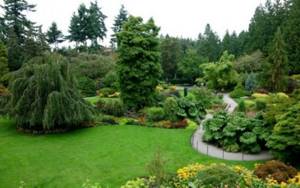
When planning a site and planting seedlings, you should be guided by the basic principles of landscape style:
- Unity of space. Identical color spots in different corners help to “assemble” the garden into a single composition.
- No excess. It is better to plant fewer trees than to build a pile where the decorative effect of each individual plant will be lost.
- Compliance with plans. Tall species are planted in the background, and dwarf varieties and shrubs move forward.
- Recording flowering time. It is better to choose plants that bloom at different times and supplement them with decorative leaves and conifers.
- Maintaining the optimal distance when planting. Every tree needs space. Tall ones are planted at intervals of at least 6 meters, medium-sized ones - 4 meters, low-growing ones - 3 meters.
By combining various ornamental and fruit plants, taking into account the general concept of the site and existing buildings, you can eventually create a real dream garden.
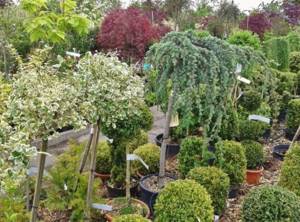
Planning a garden concept
When choosing ornamental trees for a summer residence, preference is increasingly being given to varieties that do not require constant care. Such trees can withstand changes in weather and other external factors and maintain the beauty of the garden.
In connection with this trend, the following types of ornamental trees have become popular:
- standard, having small parameters and a spherical crown;
- dwarf representatives of deciduous and fruit varieties;
- weeping vegetation;
- hybrids of ordinary columnar trees.
Another trend is the use of trees growing in forest areas for garden decoration. For example, your garden can be decorated with hornbeam, from which a hedge or wall is made.
Tip: to make the site look more lush, natural and expressive, plan a harmonious combination of decorative deciduous trees for the garden and coniferous representatives.
You can create successful decor in your garden area by combining trees with different parameters. Tall trees, reaching six meters, are suitable for decorating the back of such an area. Set a backdrop of tall vegetation to form a focal point and foreground by selecting ornamental shrubs and trees for a lower-height garden.
The choice of plant height and tree varieties depends on the style in which you plan to decorate your garden plot. For example, if the garden design involves the use of strict forms and clear lines, it is better to choose trees that can be given the necessary laconic parameters by pruning. In such gardens you can see hedges of different heights.

A hedge of low trees up to 1.5 meters high can be made using spruce, small-leaved linden, berry yew: these plants respond favorably to constant trimming. Complete high fence areas by planting riverine maple, juniper, small-leaved elm and other varieties of trees.
Unlike spacious areas where any variety will fit, in a limited space you will have to create a decorative composition using only low and medium vegetation (the height of the latter can reach three meters).
If you want the garden to look more natural, do not trim the trees to strict boundaries, but make the composition natural and careless. You can also decorate the trees with gravel and lawn grass.
Look at a beautiful selection of photos of Japanese gardens in the photo gallery and learn the nuances of creating a Japanese-style rock garden.
Ideas for using and creating a dry stream in your own landscape design are described in this article.
The role of ornamental trees in a modern garden
In addition to the natural aesthetic function of giving a person enjoyment of the beauty of nature, ornamental trees and shrubs are used by gardeners and designers to solve purely practical problems.
- Visual expansion of a too narrow or very small area.
- Decorating outbuildings, strengthening sloping areas and screes.
- Zoning the site, creating dividing screens between the vegetable garden and the garden area.
- Protecting the individual space of a small dacha from prying eyes, without erecting a fence.

How to choose the right trees according to garden parameters
First of all, let's get acquainted with the size of the trees. For small areas, it is best to choose dwarf species. If your garden is medium in size, then in this case you can plant fruit and berry and ornamental trees of medium and small height.
For example, you can plant apple trees, hawthorn, thuja, birch, bird cherry , which do not grow higher than 10 meters.
Important. Trees of the varieties described above very rarely exceed the house, thereby not blocking it from view. Also, branches or falling fruits will not be able to damage the roof or cladding of the house.
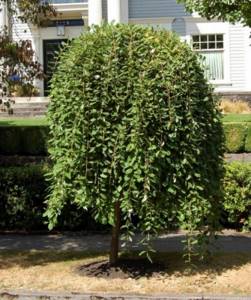
Before choosing trees for planting, you need to pay attention to the texture of the foliage and branches. You should carefully choose a landing site. For example, if you want to hide the shortcomings of your home, then it is best to plant coniferous trees. You can plant spruce and thuja, which will block the space within a radius of 4 meters from prying eyes and become a beautiful hedge.
To create shade, it is best to use broad-leaved trees, for example, maple, cherry, etc.
Recommendation. You should not use tall trees in the garden, which will block the rest of the trees from the sun. In addition, some tree species, such as maple or birch, consume a lot of water, draining your area, requiring additional irrigation.
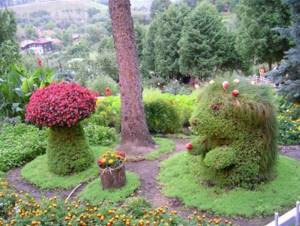
How to calculate the number of seedlings?
There are certain rules for planting trees on a personal plot. For example, trees should not be located too close to neighbors' fences or power lines. Typically, seedlings are placed at a distance of 5-6 meters. It is also necessary to maintain certain intervals between plantings so that growing trees do not shade each other.
When purchasing a seedling from a nursery, it is advisable to clarify how much space this crop requires, especially if it is exotic.
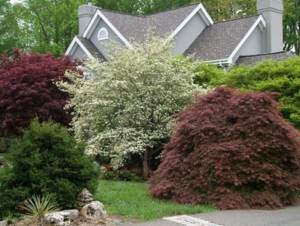
On average, the distance between trees and shrubs in an orchard should be approximately this: large fruit trees for the garden (apple trees, pears, apricots, cherries) are planted every 5-6 meters, the distance between the rows should be a little larger - about 8 meters for unhindered transportation carts and other garden work.
Plum, cherry, peach and quince are planted according to a 3x4 meter pattern, grapes - 2.5x1.5 meters, raspberries - 0.75x1, gooseberries and currants - 1.25x1.5 meters.
While the trees are small, you can create separate beds with vegetable or berry crops between them. As the beds grow, they will have to be moved to another place.
Based on these restrictions, you can estimate how many seedlings you need to purchase for a given plot.

What varieties of dwarf fruit trees are suitable for the garden?
Dwarf fruit trees are the undisputed leaders among existing dwarf trees in the garden.
However, it is worth noting that not all well-known varieties have their own dwarf counterparts. A good solution for arranging an unusual fruit garden would be nectarines, plums, peaches, apple trees, pears and many others, because it is possible to grow them even in a pot.
The most interesting and most common way of growing dwarf fruit trees is to graft them onto ordinary ones. Thus, it is possible to cultivate several dwarf fruit crops at once, which take root well and bring a generous harvest.

Dwarf pear garter.
Before purchasing a dwarf tree, you need to check its compatibility with the fruit tree of interest to which you plan to graft it.
The most convenient in this regard are apple trees. With the help of modern technologies, breeders have bred a huge number of apple trees that are easy to graft and successfully cope with many diseases.
In addition, it is quite convenient to graft a dwarf fruit tree onto a pear tree, because it is famous for its great endurance, excellent resistance to adverse weather conditions and produces a good harvest.
Dwarf trees can be grown by grafting them onto other types of fruit plants, particularly peaches and plums, because they produce large yields with proper care.
Types of garden: choose according to your capabilities
Now you need to decide what kind of garden you need: fruit and berry, ornamental or mixed. First of all, you need to consider how much time the gardener can devote to caring for the garden.
The least amount of time will be spent caring for wild trees in a park-type garden—maple, birch, and regular or blue spruce trees grow there.
Care will be reduced to pruning trees in spring or autumn, whitewashing trunks, spraying against possible pests and mowing grass between rows. You can add rowan, viburnum, lilac, and bird cherry to such a garden. They add bright colors to the garden, but are also unpretentious.
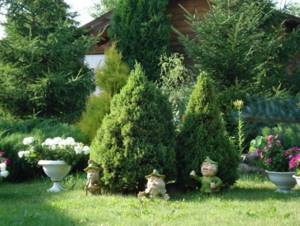
The most common type of garden is mixed, in which fruit and berry crops and ornamental crops grow. Such a garden will have to pay more attention. In mixed gardens, ornamental crops are usually planted next to buildings: a house, a veranda, a gazebo, and they are lined with ponds.
Fruit trees for the garden are planted separately.
The gardener will spend most of his time caring for the fruit and berry garden. For successful fruiting, each crop requires a whole range of measures for feeding, pruning and shaping, protection from pests and frost. In this case, the gardener will have to study a lot of information.
Advanced gardeners independently graft trees.

Disadvantages of low growing trees
Unfortunately, there are also a number of disadvantages when growing a dwarf garden:
- Serious upfront costs. Naturally, when planting it, much more planting material is required than when starting an ordinary orchard, and this increases the initial costs several times, which can shake the budget;
- Lifespan of plants. Dwarf and semi-dwarf varieties on rootstocks live much shorter than vigorous fruit trees, and you should take this fact into account when planting single specimens in the country or when planting an industrial-scale garden;
- Support costs. Many dwarf varieties of fruit trees have a shallow root system, and therefore the trees can be particularly damaged by hurricane winds, erosion, or even during a high harvest, when there are a lot of fruits on the branches and a small tree can simply fall on its side under their combined weight. For this reason, experts recommend installing supports, preferably under each individual tree, since it is almost impossible to predict which plant may tilt or fall;
- Loss and changes in variety. If planted incorrectly or simply deep, dwarf trees can lose their properties and completely switch to scion roots;
- Care. We have already said that caring for such a garden is much easier than caring for rich plantings of vigorous fruit trees, but it is worth noting the fact that maintenance procedures must be carried out much more often, which also introduces negative adjustments into the gardener’s regime and schedule. And this includes watering, pruning, and fertilizing;
- Weakness of some varieties . There are a certain number of varieties of dwarf trees that do not tolerate severe frosts well, so you need to seriously think about the right choice of planting material or constantly wrapping and sheltering the vegetation from frost;
- Need for frequent pruning . This is not a whim for the formation of the crown or the original appearance of the garden, but a natural requirement for a miniature green area. All trees in it, in particular those grafted on Paradise, require constant pruning. This will save your harvest from crushing and loss of presentation, and the garden itself from broken branches.
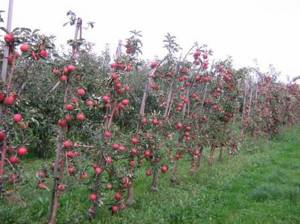
As you can see, there are many shortcomings in a dwarf garden, but it is also worth knowing that many of them can be corrected. And, if this is the case, then before starting a garden you will only need to correctly determine the planting material, and also strictly follow all planting requirements.
Garden style
You also need to decide on the style of the future garden. He can be:
- regular - it is distinguished by even rows of neatly trimmed trees, well-thought-out landscape design;
- and it looks as if all the vegetation has grown on its own.
In order to get a natural effect, you need to work hard, carefully thinking about how to place trees in the garden.
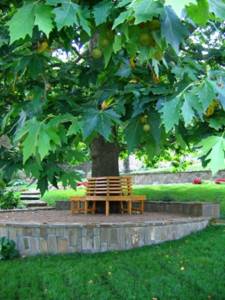
How to plan a garden?
When buying seedlings and planting them, the gardener should have a good idea of what they will look like when they grow up, that is, in a few years or decades. When choosing trees you should consider:
- soil composition on the site;
- climate in the area;
- height of groundwater;
- the shape of the site and its location;
- appearance of the tree;
- growth rate.
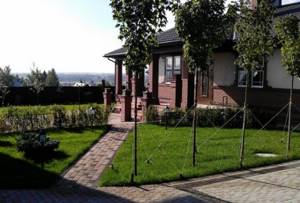
If the garden is planned to be landscape, trees should not be planted in rows. Mixed groups look picturesque, in which one large tree is next to two or three smaller ones, and the whole group is framed by several shrubs of different types.
When selecting seedlings for each such group, in addition to height, it is advisable to take into account the flowering time.
A group in which flowering continues for a long period will always look impressive. You also need to mix deciduous and evergreen plants.
The following types can be planted in the garden:
- Coniferous trees. Now they are very popular, especially types with a figured crown: spherical, elongated, spreading. Among coniferous trees there are many bactericidal trees that purify the air from bacteria and viruses. Popular conifers include juniper, cypress, thuja, spruce, pine, and cedars.
- Deciduous evergreens will delight the eye after leaf fall. These include hollies, mahonia, rhododendrons, cherry laurel, and wrinkled viburnum.
- Deciduous deciduous plants usually form the basis of the entire garden. Most often, fast-growing rowan trees, birches, and low maples are chosen. They hardly freeze in winter and always look beautiful. If the size of the garden allows, you can plant large trees such as chestnut, walnut, oak, linden, and Canadian maple.
When choosing seedlings, you must first focus on the climate.
You also need to know the height of groundwater in the area. A high groundwater level suggests swampy areas and acidic soils that need to be regularly limed. Not every tree will grow in such conditions. The most resistant to such conditions are plum fruit trees, and weeping willow and willow among ornamental trees.
Any shrubs except lilacs grow on moist soils. Mock orange, cinquefoil, black elderberry, rhododendrons, and blueberries are popular.

Varieties of dwarf apple trees
Candy
A very early ripening variety , apples ripen in the first week of August. The apple tree is distinguished by its excellent quality, round-shaped, aromatic fruits covered with rich green skin and strong, crisp flesh. Average fruit weight is 125 g.
Candy perfectly tolerates frost and sudden temperature changes.
Important! If frosts nevertheless damage the above-ground part of the tree, then it tends to recover very quickly and resume fruiting.
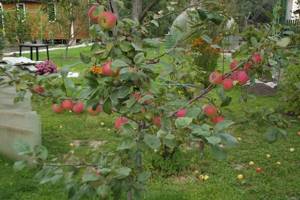
Candy.
Read more information about the Candy apple tree in this article.
Melba
This is a popular, widespread variety, the very first among dwarf varieties that have received recognition from breeders.
It attracts gardeners with its precocity (the first harvest can be harvested in the 3rd year after planting), excellent yield (up to 145 - 150 kg of fruit from one tree) and unpretentiousness , however, it is worth noting the average resistance to scab pathogens and severe frosts.
Apples ripen in the first half of August; the fruits are medium-sized (average weight 155 g), round in shape, covered with delicate skin, on which there is a crimson blush.
Inside the fruit is snow-white, tender, pleasant in structure, very aromatic. The taste is sweet, with a special caramel aftertaste.

Melba.
You can find out more about the Melba apple tree here.
Moscow necklace
Quite a new variety, instantly loved by fruit growers for its large, tasty apples, which reach full maturity in October, and also due to its early fruiting: the primary harvest can be seen already in the 3rd year after placing the tree on the site. The apple tree is resistant to the scab pathogen and tolerates frost well.
Fruit:
- Enlarged, leveled, average weight – 173 g;
- spherical regular shape;
- Covered with a loose, wine-red skin;
- They have an amazing aroma, fragile and juicy structure;
- The taste is sweet and sour, with an unobtrusive sourness.
After harvesting, the crop can be stored for up to 100 days.
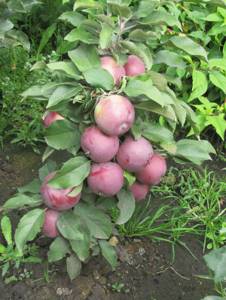
Moscow necklace.
You can read more about the Moscow Necklace apple tree here.
Wonderful
The height of the tree of this variety is from 1.6 to 2 m, depending on the type of rootstock, the crown is sweeping, with cascading branches that descend even lower under the weight of large fruits (average weight 210 g).
The fruits are spherical, slightly flattened in the center, leveled, covered with thin yellow-light green skin. The apple has a classic dessert taste with barely noticeable sourness and a pleasant consistency.
Important! One of the most important advantages of this variety is that the apple tree tolerates stagnant water well.

Wonderful.
You will learn more about the Wonderful variety from this article.
Sokolovskoye
It belongs to the category of natural dwarfs, its height is 1.1 - 2 m , fruiting is irregular, and begins in the 4th year after planting. Productivity 55 -65 kg per tree.
The fruits are flattened-spherical, covered with a delicate but dense glossy dry skin of a yellowish tint, which by the time of ripening is covered with large crimson streaks. Under the skin, the apple is grainy, dense, cream-colored, aromatic, with a sweet and sour taste.
Winter hardiness is average; too low temperatures in winter can damage fruit buds. Prolonged drought in summer negatively affects the taste characteristics of apples.

Sokolovskoe.
Read more information about the Sokolovskoye apple tree in this article.
Zhigulevskoe
A low-growing tree that very quickly enters the fruiting period, the fruits are ready for harvest in September and have a round shape. The top is covered with a dense, thin peel of a yellow-green hue; by the time it is fully ripe, it is covered with crimson vertical streaks.
The taste characteristics are excellent , the yield tends to increase from year to year.
The variety is resistant to pathogens of fungal diseases and the influence of pests, winter hardiness is above average.

Zhigulevskoe.
You can find out more about the Zhigulevskoe apple tree here.
Snowdrop
This variety of apples is a genetic dwarf, reaches a height of 1.5 m , and belongs to the stylata family . Very fast-growing, the first harvest can be harvested 3 years after planting.
Yields are high, but over time, subtle periodicity may appear.
Highly drought-resistant and frost-tolerant, the apple tree can withstand low temperatures down to -40°C.
Fruit:
- Average in weight, which varies from 135 g to 173 g;
- The shape is rounded and elongated;
- The top of the apples is covered with a thin peel, dry and smooth, pale yellow in color with raspberry-pink streaks around the perimeter of the fruit;
- The apple pulp is juicy and crisp, sweet and sour, aromatic.
The fruits are ready for harvest in early September, are universal in purpose, and can be stored for up to four months.
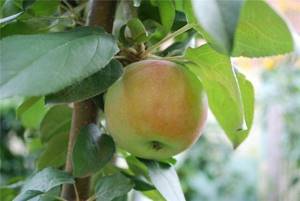
Snowdrop.
You can read more about the Snowdrop apple tree here.
Carpet
The autumn low-growing tree is recommended for cultivation in the Ural and West Siberian regions; it has amazing frost resistance and resistance to the influence of fungal pathogens.
Carpet is distinguished by early fruiting , the first harvest should be expected after 3 - 4 years after grafting, the yield is high (64 kg per tree), but periodicity may be observed over time .
The fruits are enlarged, average weight - 155 - 160 g, have a spherical, slightly flattened shape, covered with a soft, delicate skin of a yellow-light green color with a bright scarlet blush.
The inner part is dryish, with active grain, beige.
The purpose of the crop is processing and fresh consumption.
Apples can be stored in a cool place for up to one and a half months.
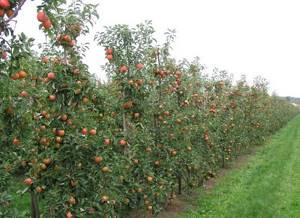
Carpet.
You will learn more about the Carpet variety from this article.
Bratchud
The apple tree is of Chelyabinsk selection and belongs to the natural stlanes. The apple tree is medium-late (harvest in mid-September), the fruits are medium (145 - 165 g), round, slightly elongated with subtle ribbing. The peel is smooth, glossy, dry, olive-green in color with an unobtrusive blush.
Inside the apple is an active white shade, medium-grained, not juicy, sour-sweet taste with a pleasant aroma. The fruits can be stored for up to 4 months, transportability is satisfactory.
The variety is distinguished by its resistance to frost. Among the disadvantages, it is worth highlighting the rather weak resistance to scab pathogens.

Bratchud.
Read more information about the Bratchud apple tree in this article.
mundane
A large-fruited, early-ripening variety characterized by excellent yield (up to 135 kg per apple tree), the first harvest can be obtained three years after planting the tree in the ground.
The fruits are large, weight on average 145 g, spherical in shape. The apple is covered with a dense, thin, aromatic green peel; by the time it is ripe, it is covered with a beautiful even blush; the taste is sweet and sour, and has received a high tasting rating.
Important! This variety has excellent scab resistance and high frost resistance.
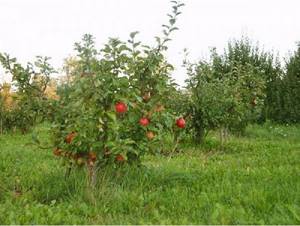
Down to earth.
You can find out more about the mundane apple tree here.
Legend
This variety of low-growing baby apple trees is an early winter variety (harvesting can be done from the beginning of October) and enters the fruiting phase in the 3rd year after planting in the garden.
The fruits are slightly ribbed, round, somewhat elongated, the main color of the durable thin skin is light green yellow, the outer color is bright crimson with deep burgundy vertical stripes. The inside is juicy, white with creamy flecks, with a distinct apple aroma and dessert taste. The weight of the fruit can vary from 175 g to 200 g.
After harvesting, the harvest can be stored for 90 days.

Legend.
You can read more about the Legend apple tree here.
Moscow red
A variety with excellent productivity, late fruiting (the harvest is harvested in the first ten days of October), is highly resistant to scab pathogens and other diseases, winter hardiness and frost resistance are satisfactory.
The fruits are smooth, round, the peel is strong, but thin, green in color; by the time of ripening, a continuous crimson blush appears on the side. The weight of apples is 135 - 185 g.
After ripening and harvesting, apples can be stored for up to 120 days.

Moscow red.
undersized
The variety is recommended for cultivation in the Central Black Earth zone, it is early-bearing and frost-resistant.
Important! The significant disadvantage is that Low-growing can be susceptible to scab infection in rainy summers.
The fruits of this apple tree are round, slightly flattened in the center, medium in size, covered with a smooth glossy skin of a yellow-green hue. By the time the hearths are removed, it becomes covered with wide crimson stripes along almost the entire perimeter of the apple.
The pulp is crisp, dense, white-green in color, sourish and very juicy with a classic apple smell.

Undersized.
Sun
This variety is late-autumn (harvesting is carried out towards the end of September), is characterized by immunity to scab pathogens, excellent frost resistance and quite satisfactory yield.
The fruits are medium in size (145 g), elliptical-sloping, leveled, covered with a strong, oily skin of green-yellow color, which by the time of maturity is covered with a bright, continuous scarlet blush.
The taste is unobtrusive, sweet and sour with a pleasant fresh fruity aftertaste. Inside, the apple is dense, homogeneous, juicy, snow-white, with a pleasant aroma.

Sun.
You can find out more about the Sunshine apple tree here.
Arbat
This variety is not only dwarf, but also columnar, characterized by its rapid entry into fruiting (the first harvest can be harvested 2–3 years after placement in the garden), resistance to diseases and pests and excellent frost resistance , which makes it possible to cultivate it in the northern regions.
The fruits are medium-sized, elliptical, covered with a durable, shiny skin of a rich red-pink hue. Inside, the fruit is aromatic, creamy, juicy and sweet, with a slight sourness.
Once harvested, they can be stored for up to several months, but may lose flavor over time.

Arbat.
You can read more about the Arbat apple tree here.
For the middle band
In order to choose the right variety of apple trees for cultivation in a certain region, you need to understand what requirements they must meet.
Thus, the middle zone of our country is characterized by frequent returning frosts in the spring, possible frosts in early autumn, as well as slushy warm winters, during which the root system of a number of garden crops can get wet.
Such weather conditions can suddenly give way to frost, which is the main problem.
Low-growing varieties for the middle zone:
- Melba;
- Candy;
- Zhigulevskoe;
- Autumn striped;
- Grushovka Moskovskaya;
- Bogatyr;
- Arbat;
- Moscow necklace;
- Bratchud;
- Legend.

